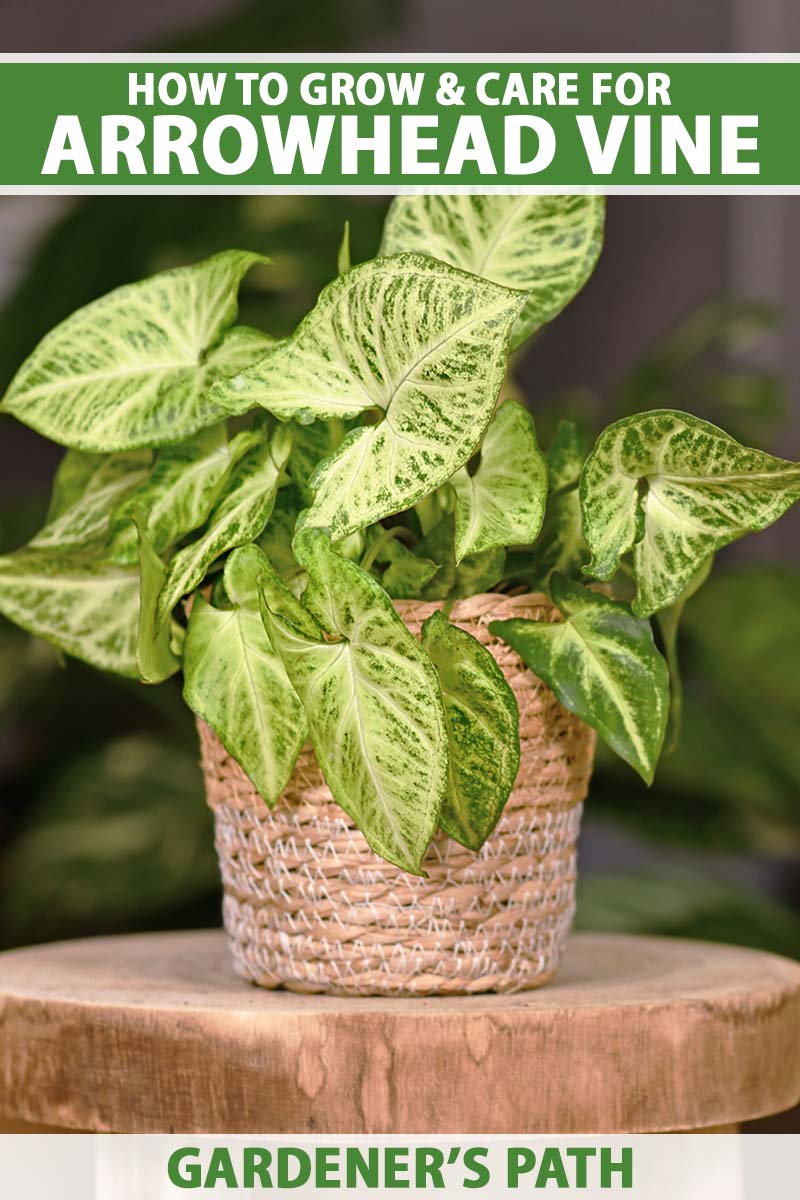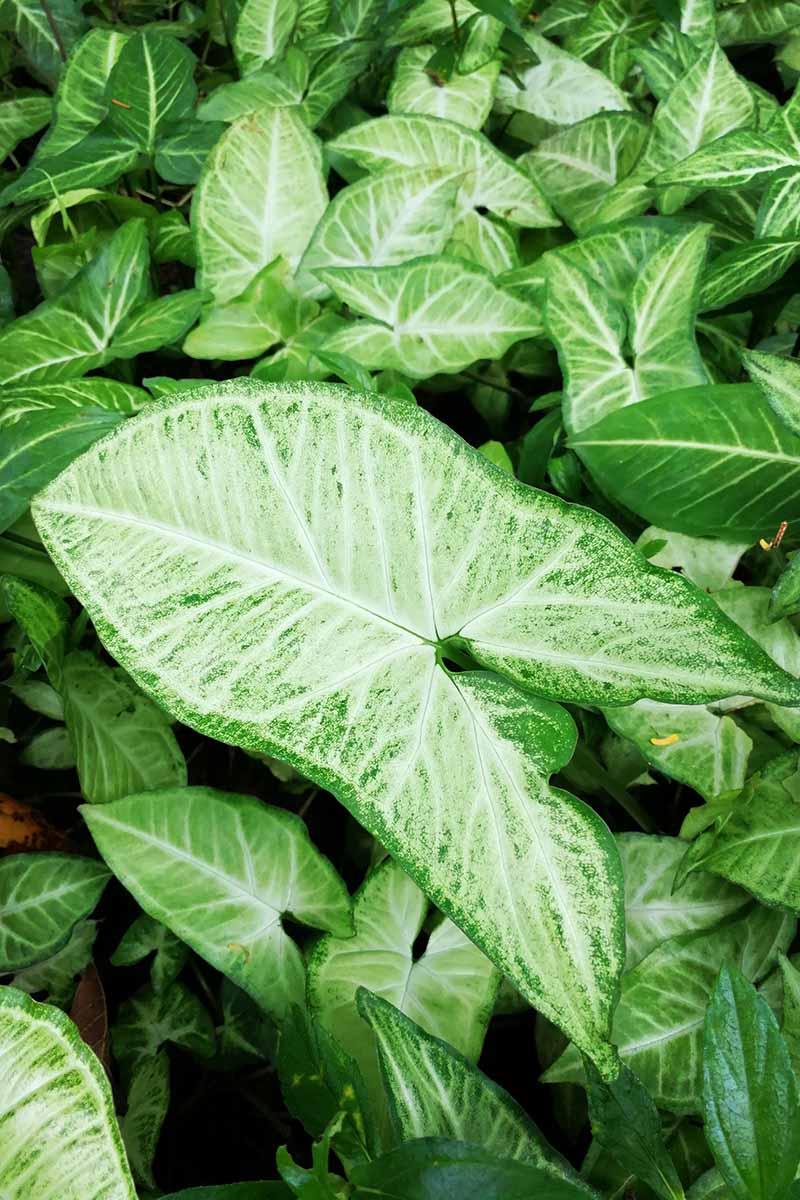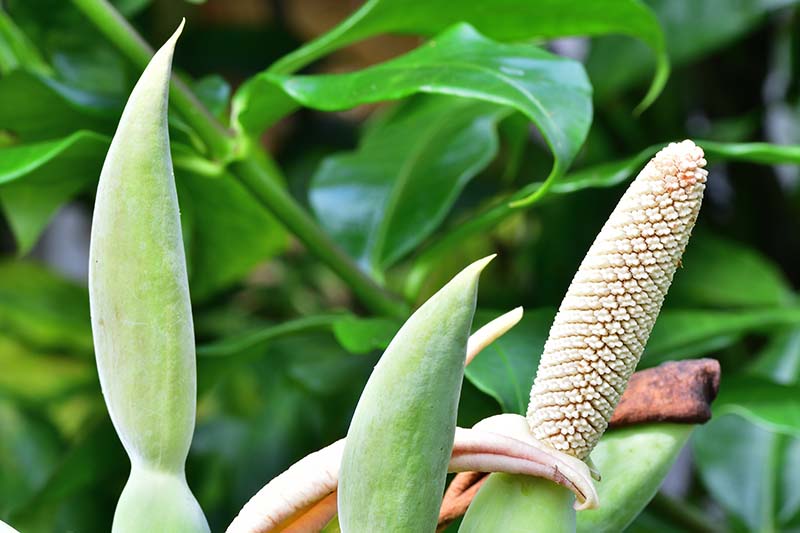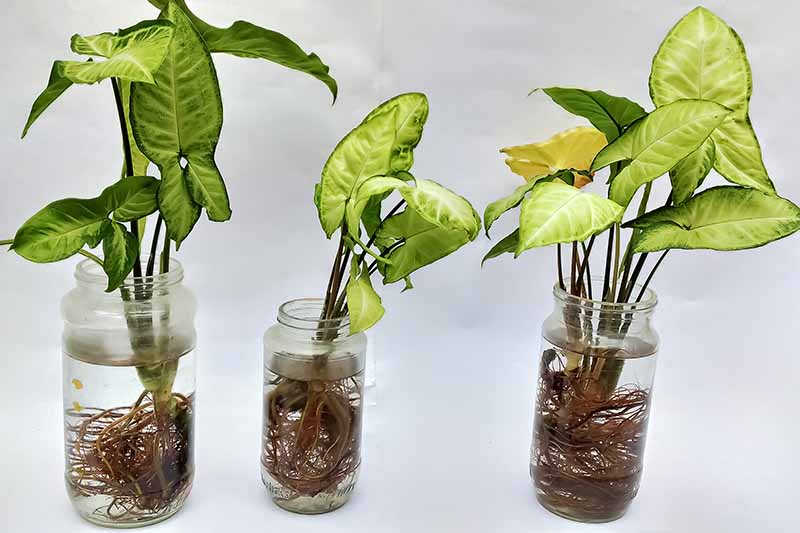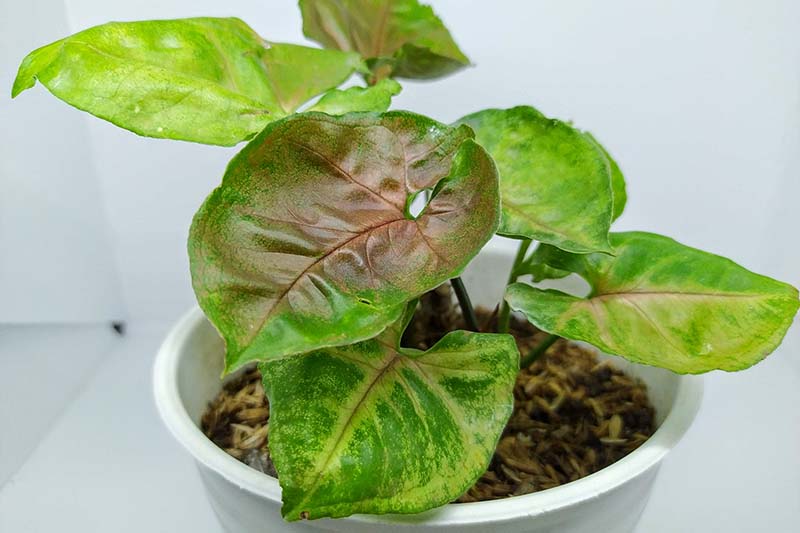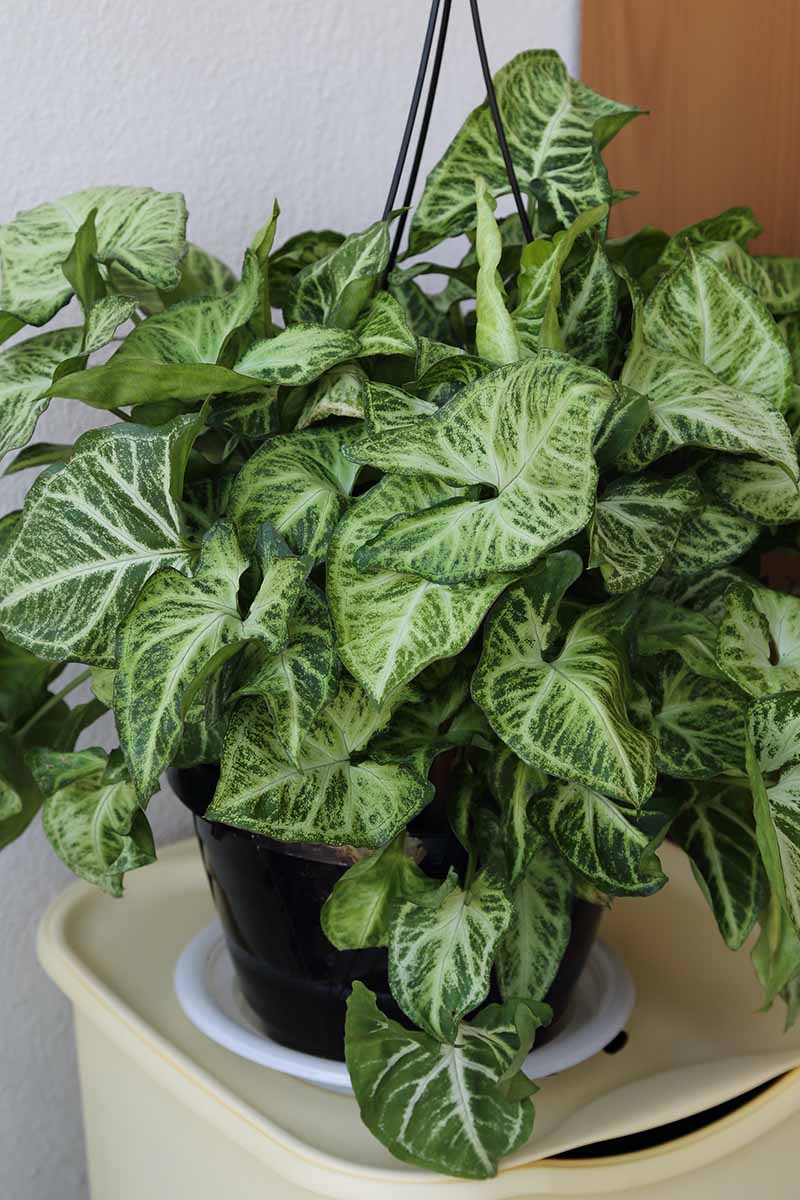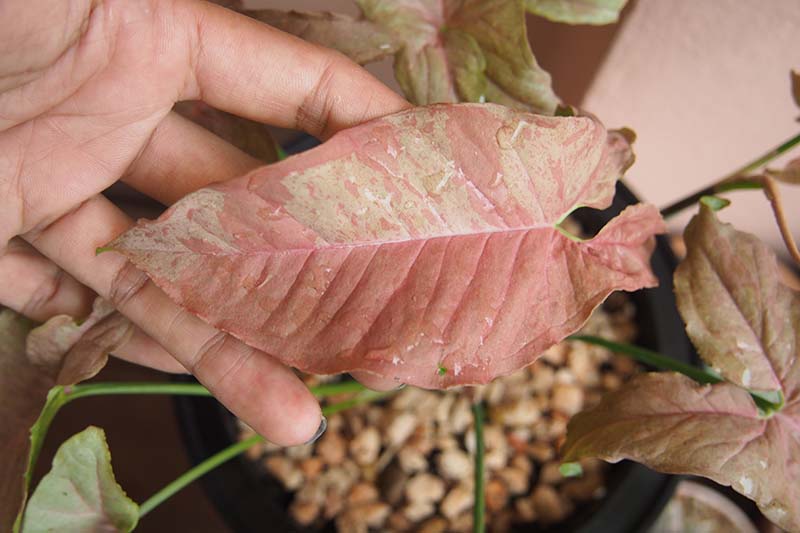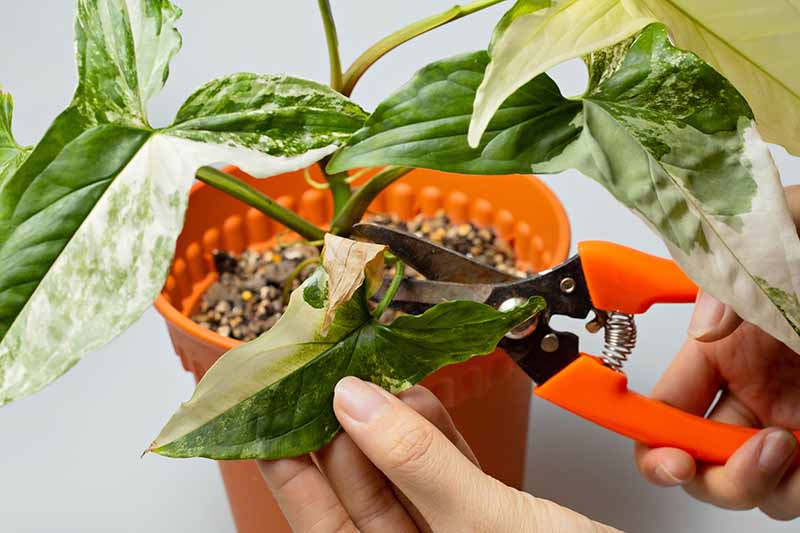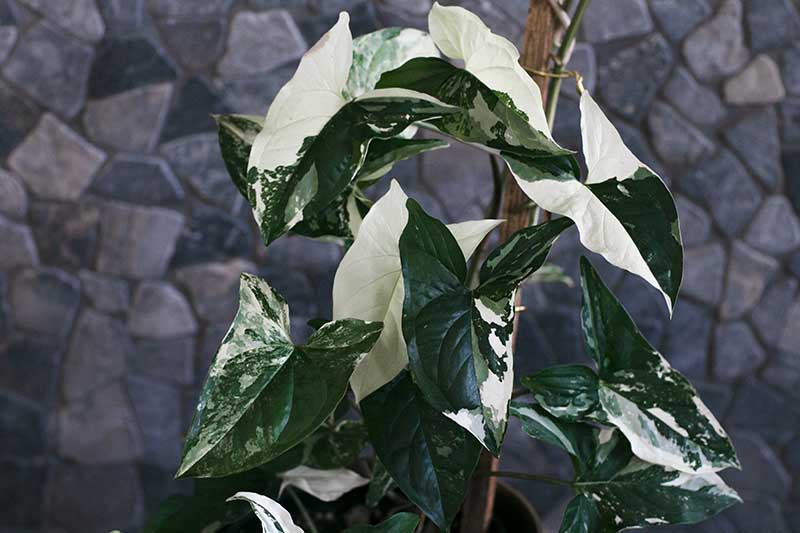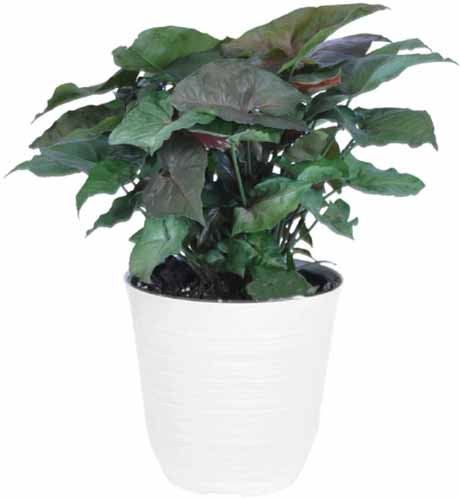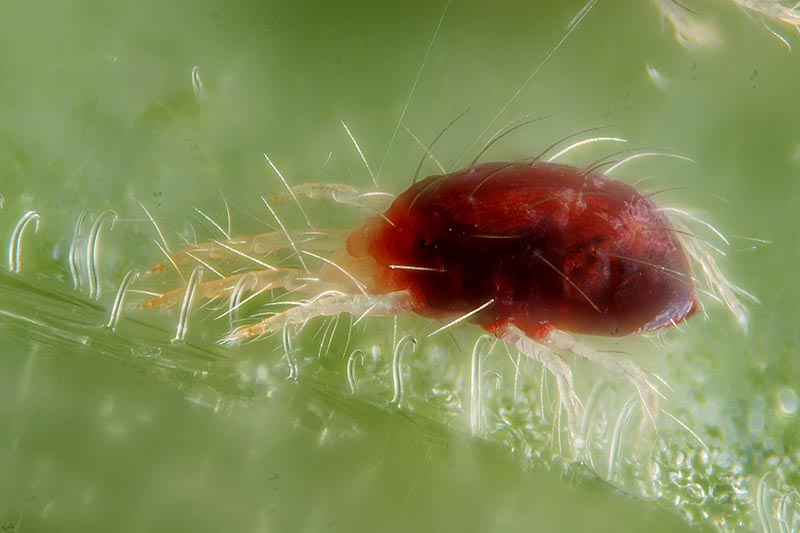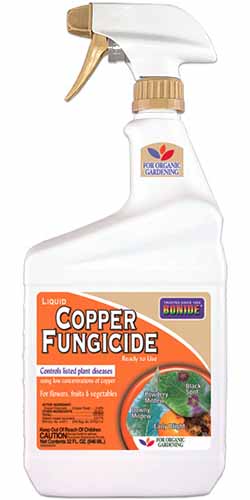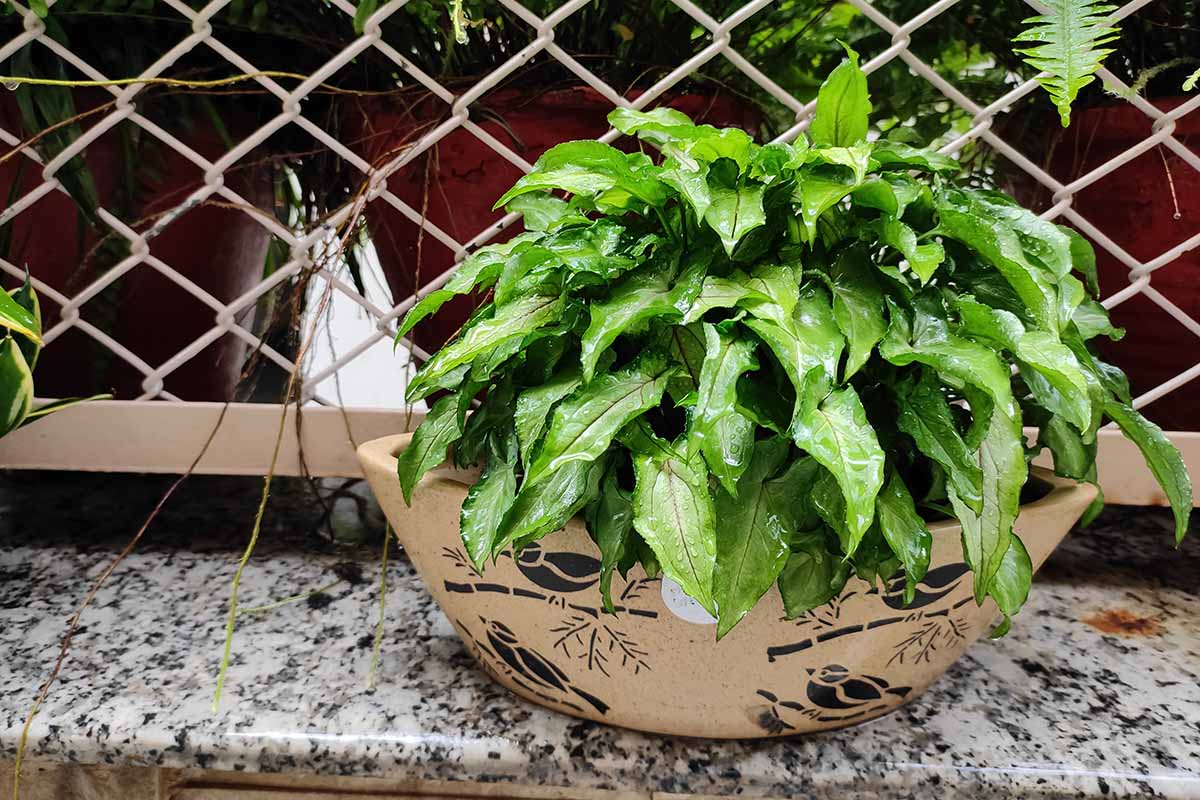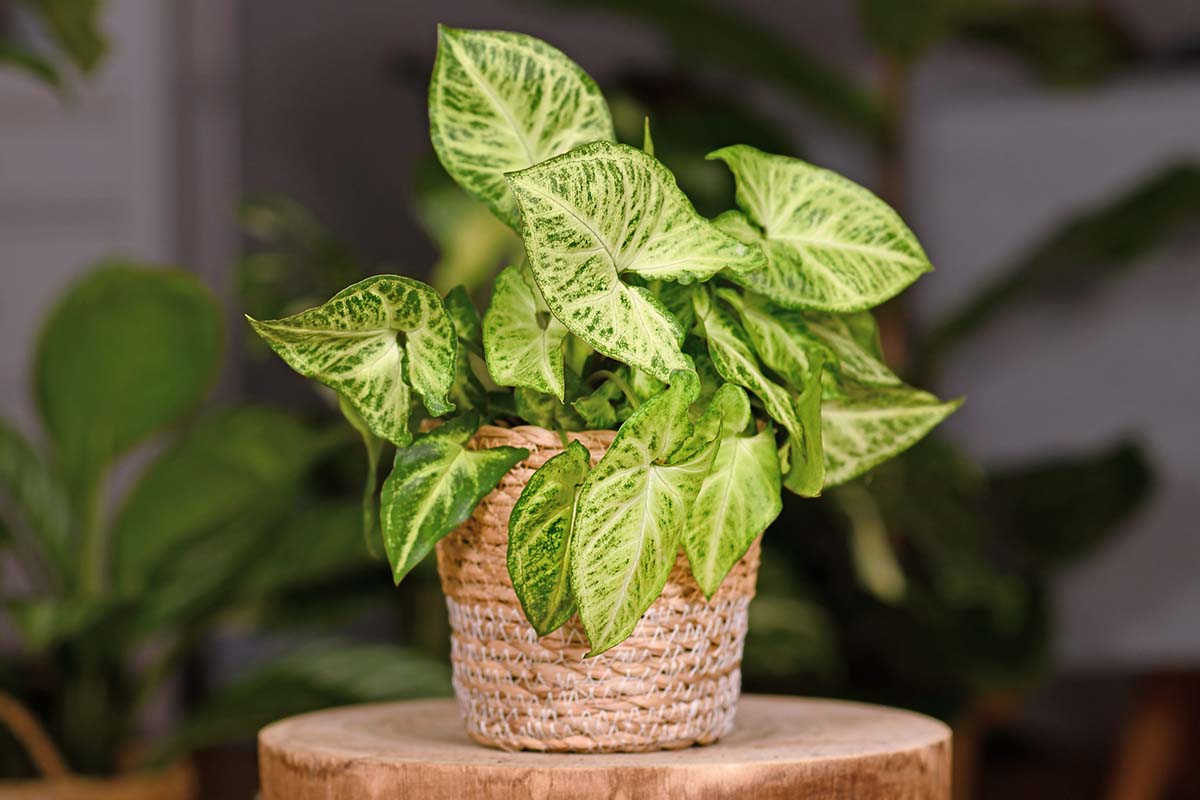Okay, you could probably manage it if you tried, but you’d really have to work at it to make one of them fail. Even better, their sturdy nature is hidden beneath a surprisingly beautiful and delicate appearance. I think that’s part of what makes them such exceptional options as houseplants – they have beauty and brawn. The foliage has a distinct arrowhead-like shape, as you probably guessed by the name, but it’s the fascinating array of colors and patterns that makes them extremely appealing. Most cultivars have soft, muted colors in shades of pink, cream, and green. A few cultivars are bolder, with deep red or emerald green coloring. We link to vendors to help you find relevant products. If you buy from one of our links, we may earn a commission. Here’s what’s coming up ahead: Whether you love all houseplants in general and you want to expand your collection, or you’re looking for a suitable species to add some color and texture to your home, arrowheads are staples for a reason. Let’s dig in.
What Is an Arrowhead Plant?
Arrowhead vine, American evergreen, five fingers, goosefoot vine, arrowhead philodendron – whatever you call Syngonium podophyllum, this tropical native is a sturdy, hard-to-kill houseplant that provides a ton of visual interest with its multicolored and uniquely shaped leaves. In case you’re curious, the word Syngonium is Greek, and “syn” means “together” while “gon” means “gonad.” It’s a reference to the fact that this plant’s ovaries are fused together in each flower. Podophyllum, on the other hand, is Latin, and it denotes leaves that attach to a stout stalk. By the way, don’t confuse this tropical houseplant with species in the Chenopodium genus, which are also commonly called goosefoot plants. While they can be delicious greens to forage, they’re completely different species that won’t make very attractive houseplants. Arrowheads are not philodendrons either, despite one of their common names. Closely related to monsteras and pothos, they have different requirements than their cousins. Goosefoot vine is native to tropical areas from Mexico to Bolivia. You can also find it naturalized across the globe in places like Hawaii, Florida, Costa Rica, and the West Indies. It shouldn’t come as a surprise that, being so difficult to kill when cultivated indoors, this plant has the potential to be invasive outdoors. For instance, in Florida and American Samoa, it has formed dense mats on the floors of forests, displacing native flora. In USDA Hardiness Zones 10 to 12, you can grow these outdoors as a groundcover or small bush in a shady area. These plants are epiphytic, starting their lives in the trees in the wild, and sending out runners along the branches as they expand. They can even send stems down into the soil to act as trunks if they need additional support. In the right conditions, they blossom with large, fleshy spathes covered in tiny flowers, and then produce red berries. The flowers are primarily pollinated by beetles in the families Rutelinae and Dynastinia. Depending on the cultivar, a happy specimen can grow up to six feet tall indoors.
Cultivation and History
Carl Linnaeus first described the genus as Arum auritum in 1763, in his work “Species Plantarum.” The species was reclassified as Syngonium in 1829 by botanist Heinrich Wilhelm Schott, and the genus was expanded as other species were reclassified and added in 1920 by botanists Heinrich Engler and Johann Krause. S. podophyllum is cultivated for sale in tropical areas, and exported across the world for use as a houseplant and garden specimen.
Propagation
Arrowhead plants respond well to propagation via stem cuttings. If you have access to a parent plant, that’s the best way to go. You can also propagate them by seed or, of course, purchase starts or more mature specimens.
From Seed
It is possible to propagate arrowhead plants from seed, but this is definitely not the preferred method. Germination is spotty and it’s hard to source seeds. On top of that, hybrids won’t grow true, and you might not end up with what you expected in terms of color. If you can find them from a reputable seller, seeds should be planted in four-inch containers filled with a 50:50 mixture of sphagnum moss and a seed starting medium. Make sure the containers have good drainage. Sow the seeds about half an inch deep, then water the medium thoroughly and keep it moist until a seedling emerges. After that, you can allow the top half-inch of the medium to dry out between waterings, and you can transplant once two or three true leaves have formed.
From Cuttings
If you have a parent plant and a cup of water, you can make little arrowhead vine babies with little effort. This process is best undertaken in the spring or summer, because the plant starts to go dormant in the fall. Arrowhead plants are vines and the process is similar to what you might do to propagate any other tropical vine. Take a cutting just below a node, the point on the vine where a leaf bud or roots may emerge. Now you have a choice to make. You can place the cutting in a container of potting medium or you can place it in water. Either method works well. The difference is that you’ll exchange quick results in terms of root development for an ability to become established quickly, depending on which option you go with. Cuttings root faster in water but the roots are weaker, so the plant needs more time to become established. Cuttings placed in a potting medium take longer to grow roots, but those roots are sturdier, and the plant will become established more quickly after the roots have formed. For the water method, place the cutting so the cut end is submerged under lukewarm water to a point just above the node. Place the jar or your choice of propagation receptacle in a spot with bright but indirect light. Replace the water every other day or so. You’ll start to see roots forming in a week or two. If not, the cutting didn’t take and you’ll need to start over. Once the roots are about an inch or two long, transplant them into potting soil in a container. To start your cutting in soil, fill a small container with a seed-starting medium. Place the cutting so the node is covered by the potting medium. Water so the medium feels like a well wrung-out sponge, and maintain this level of moisture while the roots are forming. By the time two or three weeks have gone by, roots should have developed under the soil. Give the cutting a gentle tug to see if it resists. If so, there are roots under the soil. Don’t transplant it just yet, though. Wait until you see at least two or three new leaves forming. Then you can transplant as described below.
Transplanting
Purchasing an arrowhead plant from a nursery is the most common method of obtaining one of these beauties. It certainly gives you instant gratification. Water until the excess starts to run out of the drainage hole. After about 30 minutes, dump the drained water and add additional soil if necessary, if it settled upon watering. Select a potting medium that contains orchid bark or perlite. A product such as Tank’s-Pro Cactus and Succulent Mix, with a few handfuls of orchid bark mixed into the bag works well. Tank’s-Pro Cactus and Succulent Mix You can find this potting mix available from Arbico Organics in 1.5-cubic-foot bags. Put a layer of potting mix in the base, and gently remove the plant from its existing container. Gently tease apart the roots and place the plant in the new container. The crown of the plant should be sitting at the same height that it was in its original container. Fill in around the roots with more potting soil.
How to Grow
Don’t place your arrowhead plants in full sun. You can gradually introduce them to a few hours of morning sunlight, but they do best if you keep them in bright but indirect light. In the wild, these plants are protected from the sun by the canopy of the trees that they’re growing on. That’s the sort of environment that you want to recreate. Additionally, these plants grow in humid areas where they receive a lot of moisture via rain. Your job is to try to recreate these tropical conditions. Consider using a humidifier or placing the plant on a tray filled with pebbles and water. You can also group plants together to raise the collective humidity for all of them. Add water to the potting medium when the top half-inch has dried out. It’s easy to determine when more water is needed. Just stick your finger in the soil. When it feels dry about halfway to your first knuckle, it’s time for more water. Reduce watering so that the top inch or two of soil is allowed to dry out first in the fall and winter. Having said all that, arrowhead plants are incredibly adaptable, especially if you change their conditions gradually – they will adapt to less water, less sunlight, or lower humidity. But if you want the biggest, fullest plant possible, try to give them what they crave.
Growing Tips
Grow in bright, indirect sunlightProvide a high level of humidityAllow the top half-inch of soil to dry out between wateringReduce watering during the winter
You can trim back to a node at any point when you want to create fuller, thicker growth. Since arrowhead plants are herbaceous and never woody, you can just use a clean pair of scissors to make a cut. Organic Indoor Plant Food Don’t fertilize in the fall or winter. There’s no need to prune unless you notice any dead or yellow leaves. That said, feel free to give your plant some shape. If you have one vine that’s growing a bit leggy or too long, trim it just beyond the node. This will encourage the vine to branch out rather than growing longer. Arrowhead plants are perfectly happy when they are fairly rootbound, but you will need to upgrade the pot a few times as yours matures. If the roots start to crawl out of the drainage hole, it’s time to go up one pot size. Aerial roots, however, aren’t a sign of needing to repot. Just snip them off if you don’t like the look of them. To repot, remove the plant from its container and brush away as much of the soil as possible. Transplant in fresh potting soil as described above. Once the plant has reached its mature size, replace the potting medium with fresh soil every couple of years.
Cultivars to Select
The range of arrowhead plant cultivars is astounding. They have varying leaf sizes and shapes, and an incredible variety of colors, both solid and variegated. The leaves can range from pale pink to deep green, and they may feature accents of white, cream, yellow, rust, or red. To explore the range of options, you might want to check out our guide to the best arrowhead plant cultivars. (coming soon!)
Insects
Arrowhead plants are occasionally attacked by the usual houseplant pests: aphids, mealybugs, scale, and spider mites. ‘Merry Maria’ You can find ‘Merry Maria’ plants in six-inch pots available at Home Depot. ‘White Butterfly’ features broad leaves that are pale green with dark green edges. ‘White Butterfly’ You can find ‘White Butterfly’ available in eight-inch pots available at Terrain. Other common cultivars include ‘Pink Fairy,’ with splashes of dark pink in the centers, and ‘Golden Allusion,’ which has yellow and green leaves with a pink midvein.
Managing Pests and Disease
Arrowheads are sturdy, as I’ve mentioned. That doesn’t mean they’re immune to pests and diseases, but you’ll rarely come up against any problems so long as you do your best to keep them healthy. Even if you do discover disease symptoms or an infestation, you should be able to quickly eradicate most problems from a healthy plant. Here are the issues that you might occasionally see. Chances are, if you’ve been growing houseplants for a while, you’ve come across one or more of these before. Here’s how to identify and stop them from harming your arrowhead plants:
Aphids
Aphids are small, sap-sucking insects that use their sharp mouthparts to pierce and feed on your houseplants. The result of this feeding activity is yellowing leaves, and stunted growth if enough aphids are present. They also leave behind a sticky substance called honeydew that can attract ants and sooty mold – definitely not something you want to have to deal with. That’s why you should make a habit of checking all of your houseplants periodically for aphids. In reality, your arrowhead plant is less likely to show symptoms than other more susceptible houseplant species, so you’ll need to be diligent and keep an eye out. Look for the tiny insects moving around on the stems and where the leaves meet the stem. The green peach aphid (Myzus persicae) is the most common, but many species can attack houseplants. If you spot aphids or the symptoms of their presence, there are many ways to control them. Our guide has all the details.
Mealybugs
At first glance, mealybugs (family Pseudococcidae) look a lot like some sort of fuzzy mold rather than a pest infestation, but insects they are. They’re covered in a white, cottony wax and they cluster together on the stems and leaves. The symptoms of their presence look just like what you’d see with aphids, and they also attract sooty mold. The best way to confirm an infestation is to look for the pests themselves. They’re pretty distinctive. If you do find them, isolate your plant immediately and prune away any infested leaves. Then, take some cotton swabs, dip them in isopropyl alcohol, and wipe each insect. The alcohol removes the waxy coating and leaves them susceptible to the elements. Our guide to controlling mealybugs has more tips.
Scale
Brown soft scale (Coccus hesperidum) are sap-sucking insects that typically cluster on stems or leaf veins. Like aphids and mealybugs, they produce honeydew which attracts ants and supports the growth of sooty mold. The symptoms of an infestation look similar to that of aphids and mealybugs, with the addition of dropping leaves. To tell a scale infestation apart from an issue with one of the other common pests described here requires looking for the insects themselves. They look like little brown lumps on the plant. They don’t move much, but if you scrape them away you’ll see that they’re alive. Check out our comprehensive guide to learn more information about these common pests.
Spider Mites
Red spider mites (Tetranychus urticae) are also common on houseplants. They’re extremely small, and it’s pretty rare to notice them. If you were to shake a leaf over a piece of white paper, you might see tiny red dots running around. But instead of looking for these itty-bitty spider relatives, look for fine webbing all over the leaves and stems as an indication of their presence. You may also see yellow stippling, and leaves that are turning brown or yellow. Spider mites thrive in dry, dusty conditions, so keeping the soil moist and the air humid around your plants is a smart way to keep them away. If they do attack, try to get them under control as quickly as possible. Take your plant into the shower and spray it off to knock the pests loose. Do this once a week. To learn more about how to deal with spider mites, check out our guide.
Disease
Diseases are spread by dirty tools or containers, or on infected plants that you bring into your home. You can avoid most issues by using good hygiene, and by isolating plants for a month before bringing them inside. The most common problems caused by disease pathogens are as follows:
Bacterial Leaf Spot
Bacterial leaf spot can be caused by several different strains of bacteria (Erwinia spp., Pseudomonas spp. and Xanthomonas spp.). The symptoms all look the same, regardless of which strain infects your plant. Typically, this disease occurs because the infectious pathogens are present on the plant when you purchase it, or you might bring them into your home on a different houseplant. That’s why it’s smart to isolate your plant for a bit before introducing it to the herd. You should also always clean and sanitize your tools in between plants as well. If this disease is present, you’ll see water-soaked green spots that may or may not have yellow halos around them. These can spread and merge. There is no cure for bacterial leaf spot, so you’ll have to toss the plant if you detect an infection. Make sure to sterilize the pot that the plant was in with a mixture of one part bleach and nine parts water before putting another plant in the same container.
Root Rot
Root rot isn’t always a disease so much as it is a physiological issue caused by drowning the roots in too much water. It can also be caused by one of many different pathogens, including various species of Pythium and Phytophthora water molds and Fusarium fungi, as well as Rhizoctonia solani, another fungal species. I’m guessing that you don’t have access to a lab to determine just what’s causing the rot, so you’ll need to treat for all of the potential causes. Fortunately, this isn’t as difficult as it sounds. The first step is to remove the plant from the container and wash away all of the soil. Then, carefully trim away any rotting, mushy, or black roots with a clean pair of scissors. Next, spray the roots with a copper fungicide, and thoroughly clean the container with a bleach and water mixture. Repot the plant in fresh potting medium. Now, be extra careful to avoid overwatering. A soil moisture meter can help you be sure that you aren’t overdoing it. You may also want to increase the amount of light the plant is receiving, especially if it’s winter and the days are short.
Best Uses
Arrowhead plants are more versatile than many people realize. Sure, they make lovely potted specimens, but they’re gorgeous in hanging containers too. The best way to ensure that you have both a copper spray and a soil soak on hand if you need them without needing to buy multiple products is to purchase a copper concentrate. Bonide Copper Fungicide Bonide manufactures a concentrate that’s available in a 16-ounce container, which you can buy at Arbico Organics. Because they’re epiphytic, you can also train one to grow up a moss-covered pole, or plant one in a moss-filled basket. They also make nice additions to a dish garden. But arrowhead plants have it all. With their elegantly-shaped leaves and attractive colors, you’d never know they were hiding the soul of a lion. Once you bring yours home, come back and let us know how you’re growing yours. Is it weeping elegantly out of a hanging pot? Featured as the centerpiece in a dish garden? Tell us in the comments, and feel free to share your photos! Did this guide help you to make the most of arrowhead plants? We hope so! If you’re looking to expand your indoor garden even more, read these houseplant guides next:
How to Grow and Care for Tree Philodendron HouseplantsHow to Grow and Care for Anthurium HouseplantsHow to Grow and Care for Elegant Lady Palms
